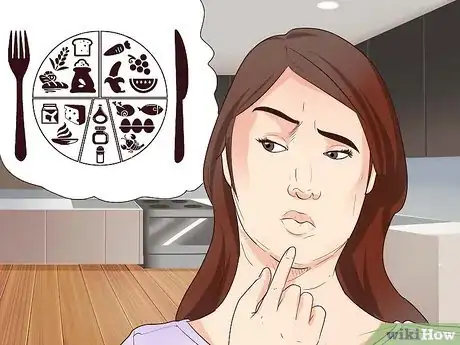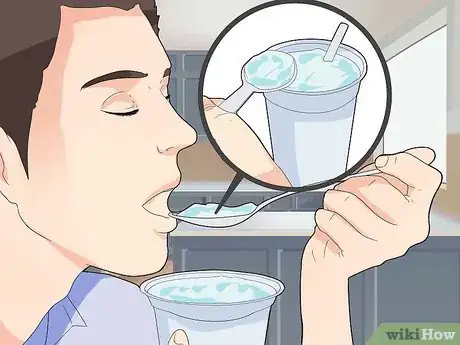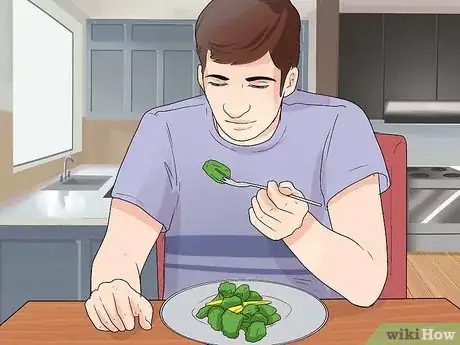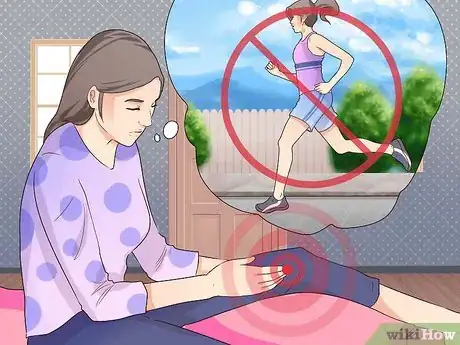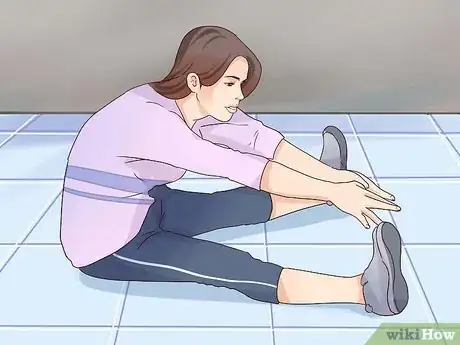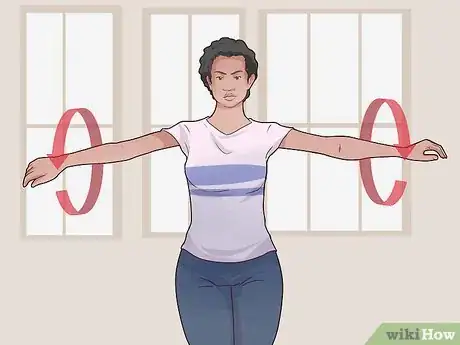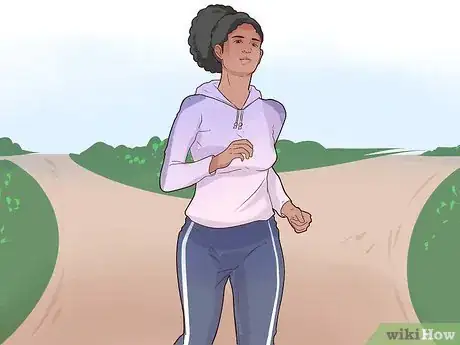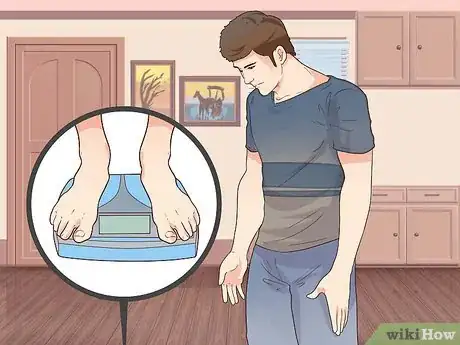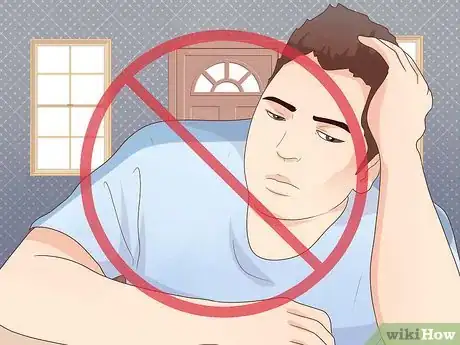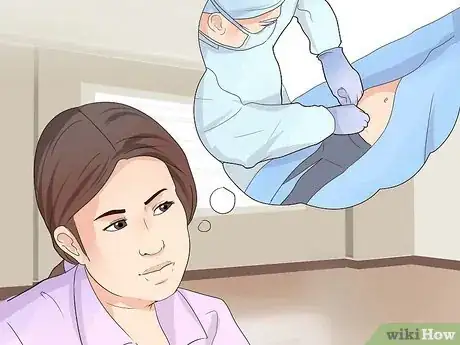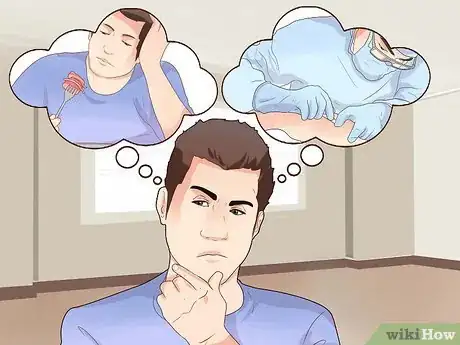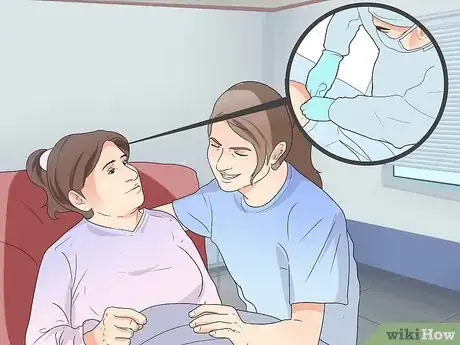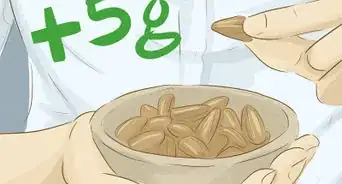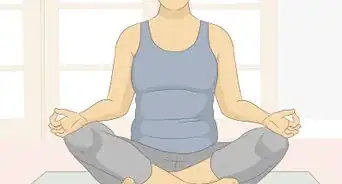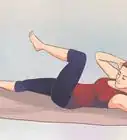This article was co-authored by Claudia Carberry, RD, MS. Claudia Carberry is a Registered Dietitian specializing in kidney transplants and counseling patients for weight loss at the University of Arkansas for Medical Sciences. She is a member of the Arkansas Academy of Nutrition and Dietetics. Claudia received her MS in Nutrition from the University of Tennessee Knoxville in 2010.
There are 17 references cited in this article, which can be found at the bottom of the page.
wikiHow marks an article as reader-approved once it receives enough positive feedback. In this case, 80% of readers who voted found the article helpful, earning it our reader-approved status.
This article has been viewed 265,787 times.
People have a wide variety of reasons to lose weight. Some attempt weight loss to improve their physical appearance while others try to lose weight in an effort to improve their overall health. Regardless of why you are trying to lose weight, it is important to remember that weight loss regimens require consistency and commitment. Here are some tips that will help you along the way.
Steps
Losing Weight through Dieting
-
1Devise a diet plan. The most important first step in shedding pounds through dieting is to select a dieting plan. Tailor that plan to your lifestyle, and establish clear weight loss goals. It is essential to construct a plan that is appropriate for your goals and medical/health history. This is best done by a dietitian. There are many different ways to achieve weight loss through dieting. Below, a few different diet plans are listed.
- Keep in mind that, whichever dieting method you choose, dietary and medical specialists suggest that losing more than an average of one to two lbs. a week is not safe for your body. Also, some studies suggest that rapid loss increases the risk of gaining weight back. In order to lose one to two pounds per week, average adults need to cut 500 to 1,000 calories per day from their diet.[1]
- Low or No Carb Diets: These diets utilize a method of eliminating carbohydrates from your diet and replacing the nutritional value of those carbohydrates with protein-rich foods. These diets, while helpful with losing weight, can lead to nutritional deficiencies, as carbohydrates are a natural part of human health requirements.[2]
- Low-Fat Diets: These diets are designed to cut the overall intake of fats from your diet, thus eliminating excess calories that can lead to weight gain. Also, decreasing fat intake lowers the risk of high blood pressure and heart disease.[3]
- Low-Calorie Diets: These diets control the overall intake of calories, found in all types of food, to help produce a reduction in the overall body mass of an individual. These types of diets can often lead to fatigue, as an individual’s overall caloric intake and, thus, energy is reduced.[4]
-
2Speak with a doctor or dietitian. It is always important to speak with your doctor before beginning a weight loss program.Advertisement
-
3Drink lots of water and take vitamins. Drinking water is not only healthy, but can also reduce hunger and the urge to eat by making you feel full. Also, taking a daily regimen of multivitamins can help replace the extra nutrients that you may be missing from your diet.[5]
- Doctors recommend that adult males drink at least 3 liters (0.79 US gal) of water a day and adult females drink 2.2 liters (0.6 US gal) of water of day.[6]
- Vitamins are essential as many people who start diet plans tend to cut out foods their bodies are used to eating, thus creating deficiencies.
-
4Eat breakfast. Dieting does not equate to skipping meals. Eating breakfast, contrary to popular belief, actually helps to kick-start your metabolism, which assists in burning excess calories throughout the day.[7]
- Start off the day with a 500 to 600 calorie meal. A very healthy and filling meal at that falls in line with this calorie intake would include a banana, a bowl of oatmeal, whole-grain toast with one to two tablespoons of peanut butter. This will provide you with a mix of carbohydrates and protein. Carbohydrates give you quick energy and protein will provide energy throughout the day.[8] [9]
-
5Eat lunch. If you have eaten breakfast and plan to eat dinner, there is no reason to eat a large lunch. However, you can still eat a healthy and filling meal at lunchtime.
-
6Eat well-portioned dinners. For most Americans, dinner is the largest meal of the day. As a result, it is very important that you limit the portions of food you eat at dinnertime. Don’t overindulge and avoid following-up dinner with a dessert.
- You should eat a dinner that falls somewhere around 400 to 600 calories. Roasted chicken with whole wheat pasta, mahi-mahi tacos, beef stir fry with broccoli and shiitake mushrooms, or pork medallions with pomegranate sauce are all tasty choices that provide the necessary nutrition while still falling in this calorie range.[12]
-
7Avoid unhealthy snacks, soda, and alcohol. Snacking on chips, candy, other unhealthy foods in between meals is devastating to one’s diet. All of the "unhealthy" snacks, or those that contain high levels of “empty” calories or high levels of fat, are deemed excess calories by your metabolism and stored for later use. Also, soda and alcohol, especially beer, are high in calories and generally unnecessary for your body’s nutritional requirements.[13]
- As an alternative, try snacking on a handful of almonds, carrot sticks and hummus, calorie-limited snack packs, or yogurt.[14]
- It is critical to point out here that diet sodas have never been proven as effective as weight loss tools. Actually, the sweetness of the diet soda tricks your body into thinking it is getting high-calorie input, without providing any actual calories. Because of this, drinking diet soda is likely to increase hunger as well as the desire for sweet, high-calorie foods.[15]
Losing Weight through Exercise
-
1Set reasonable weight loss goals. Your body can only take so much exercise before it breaks down. As such, it is important not to set workout regimens that are far beyond your body’s physical capabilities. Also, keep in mind that changing your lifestyle in minor ways (walking or biking instead of driving, taking the stairs instead of the elevator, etc.) can increase the amount of physical exercise you get throughout the day, making intensive workout sessions less necessary.[16]
- Setting goals that are too steep can create a negative environment and cause you to give up. Try setting smaller goals, week-by-week, instead of big goals that seem unobtainable.
-
2Ensure your body can handle exercise. It is important to know what your body is capable of with regards to exercise. If you have bad knees, avoid running or jogging on hard surfaces. If you have a heart condition or other ailment, be sure to check with a medical professional about workout regimens that will be safe for you.[17]
-
3Stretch before and after working out. Make sure you prepare your body for the workout ahead by stretching your muscles prior to exercising. This will help you avoid injuries. Stretching afterward will help prevent soreness.
- Be aware that injuries while working out essentially put your weight loss plans on hold. A pulled muscle or torn tendon will stop you from working out for weeks or months at a time and you will gain all the weight you lost right back.[18]
-
4Employ “low-impact” workouts. While a “low-impact” workout might sound detrimental to losing weight quickly, this simply means avoid unnecessary strain on your joints and muscles during workouts. Walking and jogging are effective and proven alternatives to running. Various machines, such as ellipticals, stair-climbers, and rowing machines, will ensure your body is not taking on unnecessary strain during cardio workouts.[19]
- In addition to running, jogging, swimming or walking, simple exercises like arm circles, up down planks, squats, leg lifts,plie squat rises,bench dips, kicks, duck walks, lunges, and other exercises can all be useful techniques to help you lose weight.
-
5Monitor how your body is feeling throughout the workout. Make sure you keep track of your pulse, breathing, and heart rate during the workout to be certain your body is handling the strain of the exercise properly. If you notice any sudden or irregular changes in your body functions, see a doctor or medical professional immediately.[20]
-
6Be consistent. Working out every once in a while will have little to no impact on your body weight. Once you have established an exercise plan, stick to it on a daily basis. There are two reasons for this. First, you will only lose weight when exercise is carried out consistently. Secondly, intermittent or periodic workouts will ultimately make it harder for you to achieve your weight loss goals because they do not contribute to increasing the time or intensity you can put into exercise.[21]
- Results can take time. Stick to it and remember that all things worth having may take a while. It will be challenging but worth it.
-
7Assess your progress. If you don’t have a scale, get one! In order to ensure that your workout is helping you lose weight, you need to be able to track your weight.
-
8Do not be discouraged. Weight loss through exercise will not happen instantaneously. It takes a long time to see measurable results and, on some occasions, you may gain weight before you lose it. Stick to your exercise plan and give it a chance to work.[22]
Undergoing Gastric Bypass Surgery
-
1
-
2Know the pros and cons of GBS. There are benefits and disadvantages to undergoing gastric bypass surgery, so it is important to know what benefits it provides as well as the drawbacks associated with the surgery.
- The pros include:
- The cons are:
- The surgery is dangerous, expensive, and may not be covered by your insurance[29]
- You can rupture your stomach if you eat too much
- Your stomach can stretch out over time, meaning the surgery is not permanent
- It does not solve the underlying issues of weight gain[30]
- It can lead to severe dietary deficiencies
-
3Consult with a physician or doctor. A medical professional may be able to help you lose weight without undergoing gastric bypass surgery. He or she may recommend alternative treatments, diets, therapies or workout programs that will help you avoid the complications and limitations of gastric bypass surgery.[31] [32]
- Also, some people who would be prime candidates for gastric bypass surgery are actually too large to undergo the procedure. This is an equally important reason to visit your doctor and discuss the realities of surgery as a solution to your weight problem.[33]
-
4Determine if the lost weight is worth the sacrifice. A doctor will tell you if you are an eligible candidate for gastric bypass surgery and should also inform you of the limitations you will face after the surgery. These limitations often include extremely limited ability to intake food, severe dietary restrictions on the types of food you can eat, and discomfort in the stomach during or after eating.[34] [35]
-
5Schedule and prepare for the procedure. Gastric bypass surgery is not to be taken lightly. It is an invasive medical procedure that will require you to take time off of work for recovery and will likely require the assistance of a friend or family member in the hours and days after your procedure. So, be sure to plan ahead.[36]
-
6Attend all follow-up appointments and follow your doctor’s instructions. Once you have undergone the gastric bypass surgery, you will need to closely follow your doctor’s recommendations for recovery to ensure a successful outcome. Also, gastric bypass surgeries require follow-up appointments to gauge how you are recovering from the procedure.[37]
- If you are undergoing this procedure ostensibly to improve your appearance, be aware that other surgeries are often required to remove excess skin and to reshape the affected area so that it will be pleasing to the eye.[38]
Expert Q&A
Did you know you can get expert answers for this article?
Unlock expert answers by supporting wikiHow
-
QuestionIs it possible to lose weight in six months?
 Claudia Carberry, RD, MSClaudia Carberry is a Registered Dietitian specializing in kidney transplants and counseling patients for weight loss at the University of Arkansas for Medical Sciences. She is a member of the Arkansas Academy of Nutrition and Dietetics. Claudia received her MS in Nutrition from the University of Tennessee Knoxville in 2010.
Claudia Carberry, RD, MSClaudia Carberry is a Registered Dietitian specializing in kidney transplants and counseling patients for weight loss at the University of Arkansas for Medical Sciences. She is a member of the Arkansas Academy of Nutrition and Dietetics. Claudia received her MS in Nutrition from the University of Tennessee Knoxville in 2010.
Master's Degree, Nutrition, University of Tennessee Knoxville Master's Degree, Nutrition, University of Tennessee KnoxvilleExpert Answer
Master's Degree, Nutrition, University of Tennessee KnoxvilleExpert Answer -
QuestionCan you lose 40 pounds in 3 months?
 Claudia Carberry, RD, MSClaudia Carberry is a Registered Dietitian specializing in kidney transplants and counseling patients for weight loss at the University of Arkansas for Medical Sciences. She is a member of the Arkansas Academy of Nutrition and Dietetics. Claudia received her MS in Nutrition from the University of Tennessee Knoxville in 2010.
Claudia Carberry, RD, MSClaudia Carberry is a Registered Dietitian specializing in kidney transplants and counseling patients for weight loss at the University of Arkansas for Medical Sciences. She is a member of the Arkansas Academy of Nutrition and Dietetics. Claudia received her MS in Nutrition from the University of Tennessee Knoxville in 2010.
Master's Degree, Nutrition, University of Tennessee Knoxville Master's Degree, Nutrition, University of Tennessee KnoxvilleExpert Answer
Master's Degree, Nutrition, University of Tennessee KnoxvilleExpert Answer -
QuestionHow long does it take for a woman to lose 70 pounds?
 Claudia Carberry, RD, MSClaudia Carberry is a Registered Dietitian specializing in kidney transplants and counseling patients for weight loss at the University of Arkansas for Medical Sciences. She is a member of the Arkansas Academy of Nutrition and Dietetics. Claudia received her MS in Nutrition from the University of Tennessee Knoxville in 2010.
Claudia Carberry, RD, MSClaudia Carberry is a Registered Dietitian specializing in kidney transplants and counseling patients for weight loss at the University of Arkansas for Medical Sciences. She is a member of the Arkansas Academy of Nutrition and Dietetics. Claudia received her MS in Nutrition from the University of Tennessee Knoxville in 2010.
Master's Degree, Nutrition, University of Tennessee Knoxville Master's Degree, Nutrition, University of Tennessee KnoxvilleExpert Answer
Master's Degree, Nutrition, University of Tennessee KnoxvilleExpert Answer
Warnings
- Don't exercise excessively. If you are uncomfortable or in pain, stop. You are hurting and straining yourself!⧼thumbs_response⧽
References
- ↑ http://www.eatingwell.com/nutrition_health/weight_loss_diet_plans/what_does_a_1500_calorie_day_look_like
- ↑ http://www.mayoclinic.org/healthy-lifestyle/weight-loss/in-depth/low-carb-diet/art-20045831
- ↑ http://www.mayoclinic.org/healthy-lifestyle/weight-loss/in-depth/weight-loss/art-20048466
- ↑ http://www.mayoclinic.org/healthy-lifestyle/weight-loss/in-depth/weight-loss/art-20048466
- ↑ http://www.mayoclinic.org/healthy-lifestyle/weight-loss/in-depth/weight-loss/art-20048466
- ↑ http://www.mayoclinic.org/healthy-lifestyle/nutrition-and-healthy-eating/in-depth/water/art-20044256
- ↑ http://www.caloriesecrets.net/what-to-eat-for-breakfast-if-you-want-to-lose-weight/
- ↑ http://www.caloriecount.com/
- ↑ http://www.eatingwell.com/nutrition_health/weight_loss_diet_plans/what_does_a_1500_calorie_day_look_like
- ↑ http://www.caloriecount.com/
- ↑ http://www.eatingwell.com/nutrition_health/weight_loss_diet_plans/what_does_a_1500_calorie_day_look_like
- ↑ Jillian Michaels, The Master Your Metabolism Cookbook (New York: HarperCollins, 2005)
- ↑ http://www.health.com/health/gallery/0,,20513624,00.html
- ↑ http://www.health.com/health/gallery/0,,20778689,00.html
- ↑ http://www.health.com/health/gallery/0,,20778689,00.html
- ↑ http://www.health.harvard.edu/healthbeat/10-tips-for-exercising-safely
- ↑ http://www.mayoclinic.org/healthy-lifestyle/fitness/multimedia/stretching/sls-20076840
- ↑ http://www.mayoclinic.org/healthy-lifestyle/fitness/multimedia/stretching/sls-20076840
- ↑ http://www.health.harvard.edu/healthbeat/10-tips-for-exercising-safely
- ↑ http://www.health.harvard.edu/healthbeat/10-tips-for-exercising-safely
- ↑ http://www.mayoclinic.org/healthy-lifestyle/weight-loss/in-depth/exercise/art-20050999?pg=1
- ↑ http://www.mayoclinic.org/healthy-lifestyle/weight-loss/in-depth/exercise/art-20050999?pg=1
- ↑ https://www.nlm.nih.gov/medlineplus/ency/article/007199.htm
- ↑ http://www.mayoclinic.org/tests-procedures/bariatric-surgery/basics/definition/prc-20019138
- ↑ https://www.urmc.rochester.edu/encyclopedia/content.aspx?ContentTypeID=134&ContentID=154
- ↑ https://www.urmc.rochester.edu/encyclopedia/content.aspx?ContentTypeID=134&ContentID=154
- ↑ https://www.urmc.rochester.edu/encyclopedia/content.aspx?ContentTypeID=134&ContentID=154
- ↑ https://www.urmc.rochester.edu/encyclopedia/content.aspx?ContentTypeID=134&ContentID=154
- ↑ https://asmbs.org/patients/bariatric-surgery-procedures#bypass
- ↑ https://asmbs.org/patients/bariatric-surgery-procedures#bypass
- ↑ https://www.nlm.nih.gov/medlineplus/ency/article/007199.htm
- ↑ http://www.mayoclinic.org/tests-procedures/bariatric-surgery/basics/definition/prc-20019138
- ↑ https://www.nlm.nih.gov/medlineplus/ency/article/007199.htm
- ↑ https://www.nlm.nih.gov/medlineplus/ency/article/007199.htm
- ↑ http://www.mayoclinic.org/tests-procedures/bariatric-surgery/basics/definition/prc-20019138
- ↑ https://www.nlm.nih.gov/medlineplus/ency/article/007199.htm
- ↑ http://www.mayoclinic.org/tests-procedures/bariatric-surgery/basics/definition/prc-20019138
- ↑ https://www.nlm.nih.gov/medlineplus/ency/article/007199.htm
About This Article
To lose 60 pounds, follow a dietary plan that reduces your caloric intake by 500 to 1,000 calories a day, which should help you lose 1-2 pounds a week. Make sure your plan includes healthy, balanced meals. Additionally, try to avoid soda and other unhealthy snacks, like chips and candy, that are filled with “empty” calories. You should also exercise consistently, taking your current fitness level into account. For example, stick to low-impact workouts like walking or swimming if you’re not used to exercising. For more tips from our Dietary co-author, like how to put together 3 meals a day that hit your dietary targets, scroll down!
